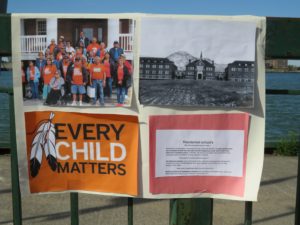Canada’s first National Truth and Reconciliation Day

Photo by Colin Bannon
Canada has been increasing awareness about issues surrounding Indigenous people and the history of residential schools. Part of that awareness is a new national holiday, the National Day for Truth and Reconciliation.
National Day for Truth and Reconciliation is dedicated to recognizing indigenous children were forced to attend residential schools, a type of boarding school in Canada. More than 100 of these schools operated between 1880 and 1996. The schools were located across Canada and many children were abused, mistreated and killed all because of their race. The last residential school closed in 1996.
Now, Canadians across the country are remembering these children and the survivors of the residential schools. Around 150,000 Indigenous children attended residential schools. Canadians wear orange to remember these children, and the term “Every Child Matters” is said to remind us that indigenous children matter and deserved much better.
Books, festivals and movies are made to demonstrate the realities of the residential school system. There are hundreds of stories of children who attended residential schools and what they had to deal with.
Windsor marked the first National Truth and Reconciliation Day by paying respects in ways such as offering a five-day film festival with other learning opportunities, encouraging everybody to wear orange and shining an orange light on city hall.
Truth and Reconciliation Call-to-Action #80 states that Sept 30 will serve as a day of remembrance, reflection, action and learning not only for Canadians, but for anyone to recognize and remember the history and long-standing effects of residential schools.
Muriel Sampson is a counsellor at St. Clair College who is encouraging everyone to learn more about the history of residential schools and show their support.
“We just observed the first National Day of Truth and Reconciliation and I saw many people wearing orange this year. In my opinion, it was a recognizable increase in support. We must give thanks and acknowledge all of those who have come before us and have done the hard work of moving Truth and Reconciliation to where it is now. We must also give thanks to those who continue to move this forward. It is up to us to join the circle and continue to strengthen the movement towards Truth and Reconciliation,” Sampson said.
There are many steps to take as Canadians to raise awareness for indigenous children and people and learning the from the past is a huge step. Kayla Murphy, an indigenous services counsellor at St. Clair College, says there are many things we can do to raise more awareness to FNMI people and their history.
“There appears the general level of awareness in Canada is increasing, and though this is great, it also needs to happen more. This national holiday is an important step to keep the pressure to keep this reflection, engagement and learning journey going,” Murphy said. “We encourage all to take actionable steps towards reconciliation. Take time to learn about the history of Indigenous Peoples in Canada, and to contemplate any personal discomfort resulting from Canada’s actions.”
With National Truth and Reconciliation Day being held once a year, support and awareness for indigenous people is encouraged every day and only aims to improve each year and helping to improve the lives of residential school survivors and indigenous peoples.


